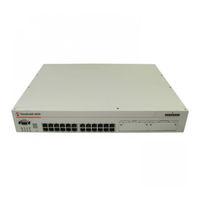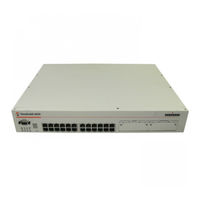Alcatel OmniSwitch 6602-48 Manuals
Manuals and User Guides for Alcatel OmniSwitch 6602-48. We have 4 Alcatel OmniSwitch 6602-48 manuals available for free PDF download: Network Configuration Manual, Management Manual, Getting Started Manual, Configuration Manual
Alcatel OmniSwitch 6602-48 Network Configuration Manual (654 pages)
OmniSwitch 6600 Series
Table of Contents
-
-
-
-
-
-
-
-
In this Chapter129
-
-
-
How MSTP Works132
-
-
-
In this Chapter149
-
-
-
In this Chapter169
-
-
VLAN Rule Types172
-
DHCP Rules173
-
Binding Rules174
-
Protocol Rules174
-
Port Rules175
-
-
-
-
-
The Vlans190
-
-
-
-
In this Chapter195
-
-
-
In this Chapter201
-
-
-
AMAP Defaults202
-
AMAP Overview203
-
Configuring AMAP205
-
-
In this Chapter209
-
802.1Q Overview211
-
-
-
In this Chapter221
-
-
-
-
In this Chapter239
-
-
-
-
-
-
In this Chapter279
-
IP Defaults280
-
IP Overview282
-
-
-
IP Forwarding284
-
-
IP Configuration
291-
Managing IP297
-
-
In this Chapter303
-
Ipv6 Defaults304
-
Ipv6 Overview306
-
-
-
In this Chapter319
-
RIP Defaults320
-
RIP Overview322
-
RIP Version 2323
-
-
RIP Routing323
-
RIP Options327
-
-
RIP Security332
-
-
-
In this Chapter335
-
RDP Defaults336
-
RDP Overview339
-
RDP Interfaces340
-
-
-
-
In this Chapter347
-
-
-
-
In this Chapter371
-
VRRP Defaults372
-
VRRP Overview374
-
Why Use VRRP375
-
-
ARP Requests376
-
ICMP Redirects376
-
-
VRRP Tracking377
-
-
-
-
-
In this Chapter389
-
-
-
Server Defaults391
-
Server Overview393
-
Ace/Server396
-
RADIUS Servers397
-
LDAP Servers403
Advertisement
Alcatel OmniSwitch 6602-48 Management Manual (264 pages)
OmniSwitch 6600 Family
Table of Contents
-
Using Telnet
24 -
Using FTP
25 -
-
-
-
-
-
Enabling DST74
-
-
-
CMM Files91
-
-
-
Using the CLI122
-
-
CLI Overview
122 -
CLI Services
129 -
-
Alcatel OmniSwitch 6602-48 Getting Started Manual (76 pages)
OmniSwitch 6600 Family
Brand: Alcatel
|
Category: Network Router
|
Size: 2 MB
Table of Contents
-
-
Features7
-
-
-
-
-
Os6600-P2413
-
Os6600-U2413
-
Os6602-2413
-
Os6602-4813
-
Os662413
-
Os664813
-
-
Advertisement
Alcatel OmniSwitch 6602-48 Configuration Manual (62 pages)
OmniSwitch 6600 series Advanced Routing Configuration Guide
Table of Contents
-
-
OSPF Areas18
-
Stub Areas21
-
-
Advertisement



